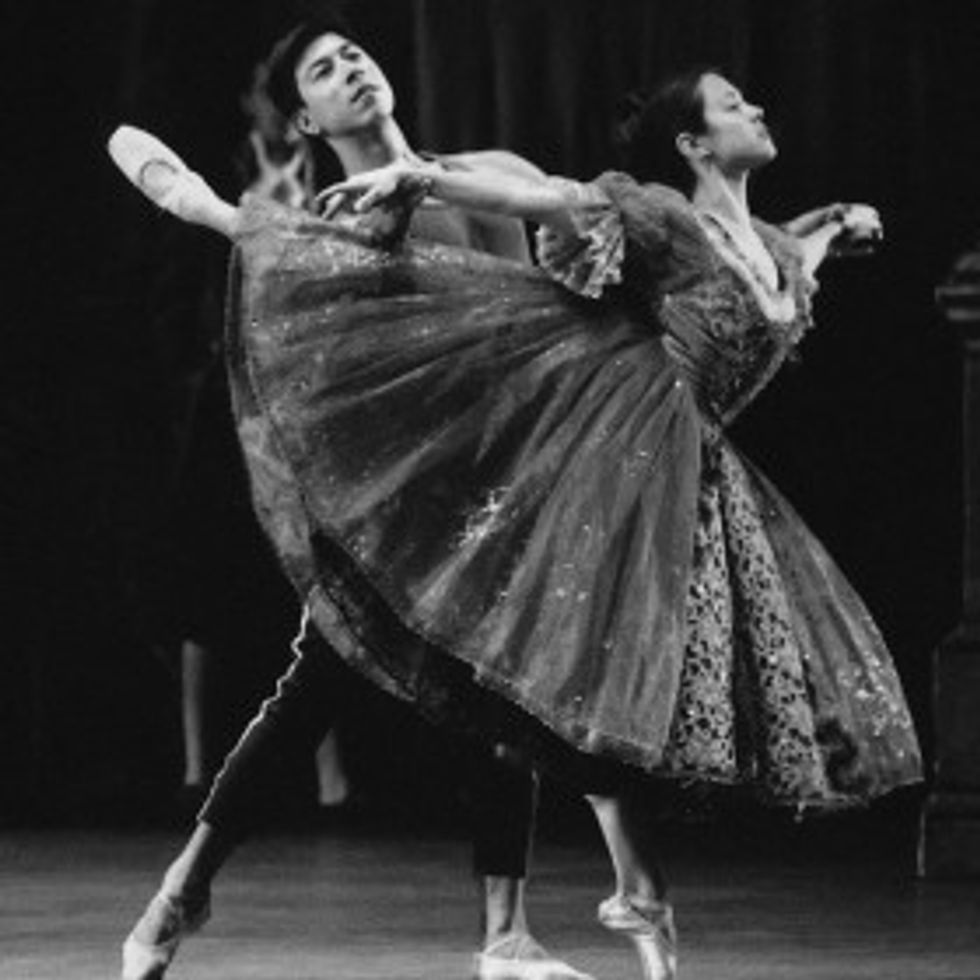Photographer Erin Baiano

Erin Baiano and Flavio Salazar in Cinderella. Photo by Rosalie O’Connor
Erin Baiano stands by a window at a photo shoot, calling out directions in two different languages: a dancer’s and a photographer’s. On her right is an assistant; Erin asks him to fix a light that’s causing shadows in her frame. Then she scurries to the center of the room to address a dancer, her subject.
Her diminutive body propels into an arabesque, camera in hand, and the dancer nods in agreement.
It’s not every day a photographer executes a dance move before snapping a shot, but Erin has experience on both sides of the lens. Here’s a look at how the former American Ballet Theatre dancer brings the languages of movement and photography together.
Movement in Manhattan
Born and raised in the heart of Manhattan, Erin became a student at The School of American Ballet when she was just 9 years old. By 18, she had become well versed in the Balanchine technique and decided she wanted to expand her vocabulary to include the world of full-length classical productions. So she auditioned for American Ballet Theatre and was hired.
“Speed was my thing,” she says of her knack for swift footwork, a benchmark of SAB’s training. “When I got to ABT, it was such a huge style change.”
Erin adapted quickly to the technical demands. What she did have trouble getting used to, however, was the frustrating reality of a professional dancer’s schedule—including layoffs. A few performances into her job at ABT, Erin found herself with months of free time before the next rehearsal period started.
During this downtime, a chance meeting with an old acquaintance proved pivotal in Erin’s life: One day while walking around the Upper West Side, she ran into Paul Kolnik, resident photographer for New York City Ballet, who used to take pictures of her when she was a student at SAB. During the course of their conversation, Kolnik offered Erin a job doing administrative work at his studio. Although she had no interest in photography, that didn’t stop her from accepting the gig.
She worked for Kolnik for a few months, but ABT soon resumed rehearsals and her foray into the world of photography was a forgotten blip on her radar. “I never even took a camera on tour,” she says.
A Leap Into the Lens
Erin danced with ABT for six more years, performing classical staples like Giselle, as well as pieces by Twyla Tharp and Balanchine. Then in 2000, Erin retired. At first, she thought she’d get a liberal arts degree and plot her next move while at school, but life had other plans for her.
Another run-in with Kolnik led to a second job at his photography studio. Only this time, Erin got her hands wet; he taught her how to develop pictures in a darkroom. Beneath the glow of the red light required for exposing film, she began absorbing lessons about dance photography by staring at images of the city’s best dance artists on a daily basis.
Then a huge, unexpected opportunity popped up. “Paul had accidentally double-booked himself,” Erin recounts with a hint of humor. “He needed to be shooting in Seattle and NYC at the same time.”
Instead of canceling one of his commitments, Kolnik tossed a camera into Erin’s hands. He reviewed a few key terms: A fast shutter speed would help keep the dancers from appearing blurry, and as long as she opened the aperture (or lens hole) wide enough, she would be able to let in the right amount of light to accurately capture the stage.
Erin felt her two worlds collide as she began photographing NYCB at the New York State Theater. “I liked the adrenaline rush and the pressure,” she recalls of her first night as a solo professional photographer. “I hadn’t felt that since I was a dancer; I was anxious, but excited.”
Late nights were spent critiquing her photos with Kolnik. Soon she was as confident in the back of the theater as she had been onstage. Months passed, and as Kolnik took on more Broadway shoots, Erin got to work with NYCB on a regular basis. Eventually, she became the second photographer for Kolnik’s studio.
Expanding the Frame
Now 33, Erin has established herself as a go-to photographer for various publications and is beginning to push her limits beyond the dance world. She is crossing over to areas including music, taking pictures of artists like Duffy and M.I.A. “When I shoot musicians, I don’t understand,” she says, “so I am looking at it with a naivete.”
And when you open the Arts section of The New York Times (or any issue of Dance Spirit!), her work is sprinkled throughout. “Shooting dancers is fantastic because I understand them and there is a love that comes through,”she says.
In addition to knowing when she has captured the proper line in an image, she has compassion for dancers and knows how difficult their lives can be, which makes her subjects more comfortable during a shoot. Most recently, she became the company photographer for Christopher Wheeldon’s troupe, Morphoses, whose choreographic shapes excite her.
But whatever the job, Erin is still inspired every time she lifts her camera. “Ganesh is a Hindu god and the remover of obstacles,” she says of the tattoo that adorns her left arm. “He reminds me to get out of my own way and to not be an obstacle to myself.”
After years of working steadily, she hopes to expand the scope of her photography to include portraiture, and one day, have her own studio. But for now, she’s happy taking it one shot at a time.




